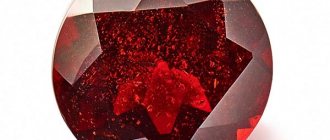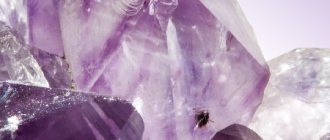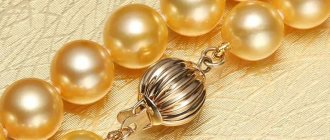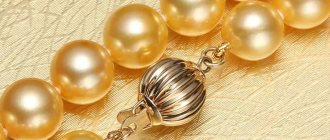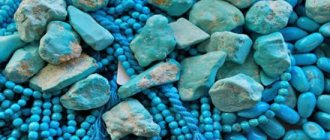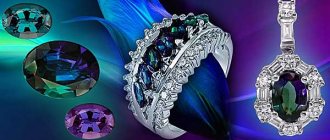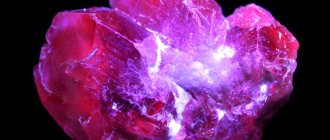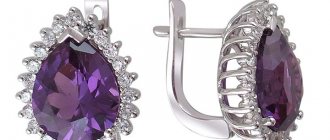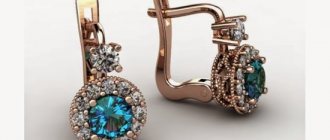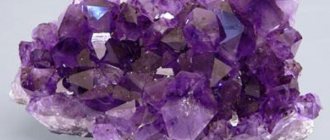Artificial alexandrite is increasingly replacing natural alexandrite. But even a laboratory-grown crystal is a coveted gem in many people’s collections. This stone has the property of changing color under different lighting conditions. Alexandrite stone is almost never found in nature, which explains its high cost. But modern industry has learned to produce synthetic alexandrites, which are inferior to their natural counterparts only in the range of shades. Let's find out how to distinguish natural alexandrite from artificial one, and what are the properties of this jewelry.
History of the gem
The alexandrite stone has a rich history; mentions of it are found in ancient Indian treatises. According to the official version of many researchers, the gem received its name in 1834. The Swedish scientist Nordenskiöld searched for precious stones in the area of emerald mines in the Urals. In the mica dumps, the seeker found a beautiful stone of an unusual color. Its color shimmered under the rays of the sun from yellow to green. Initially, the scientist suggested that it was an emerald. However, the mineral found was superior to emerald in hardness. In the evening, in the light of a candle flame, the gem sparkled with purple-red hues.
Count Perovsky, while in St. Petersburg, carefully studied the mineral and classified it as a separate group of gems. The first attempts to name the find “diaphanite” (translated from Greek as “double shine”) were unsuccessful.
The stone of a beautiful shade was presented to the general public on the day of the coming of age of the future Emperor Alexander II.
Taking into account the fact that this mineral is a leader in counterfeiting and counterfeiting, the question of how to distinguish natural alexandrite from synthetic one is very relevant.
Alexandrites were not sold in the USSR
For a century and a half, alexandrite was mined only in the Urals. These gems were very popular among the nobility, who dreamed of having rings, earrings or necklaces with the color-changing stone.
The mineral appeared extremely rarely abroad, so it was sold at a price significantly higher than the cost of diamonds of the same size. The inability to verify the nature of the gem allowed Russian traders to sell crystals whose authenticity was in doubt.
After the Great October Socialist Revolution, the crystal was recognized as the property of the republic and Soviet alexandrites began to be actively supplied to foreign markets, thus replenishing the country’s budget. Jewelry with this crystal was expropriated in the USSR and also sold abroad.
Only a variety of imitations of alexandrite were sold on the domestic market, as well as a huge number of fake stones made of painted glass. It could be chromium-enriched corundum, cubic zirconia (artificial diamond) or green spinel.
In the former Soviet Union, it is almost impossible to find jewelry containing alexandrite. Perhaps they are still in some old collections, but the bulk are represented by skillfully made fakes.
Description of the mineral
Before you learn how to distinguish alexandrite from other stones, you need to get acquainted with the description of the mineral.
Alexandrite is a chrysoberyl. It has extreme hardness. When exposed to artificial natural light, it can change its color. Jewelers call this property reverse.
Rays of light, refracted through the crystal lattice of a mineral, give a different spectrum. As a result, we see different shades.
The reverse is also explained by the special chemical composition of the gem. Alexandrite contains trivalent chromium and absolutely no silicon.
Properties of the mineral:
- Color – yellow, green, blue, purple, red. The gem can change its color in infrared and fluorescent lighting.
- Hardness on the Mohs scale is 8-8.5 units. Alexandrite is slightly inferior to diamond (10 units) and sapphires (9.5 units).
- Density – 3.6-3.8 g/cm³.
- Resistant to acids (with the exception of hydrofluoric acid and boric acid).
- Alkalis have an adverse effect on the mineral.
- Melting point – 1800°C.
- Refractive index – 1.74-1.75.
- Optimal birefringence indices are 0.008-0.01.
- Does not respond to magnets. In some cases, a slight attraction is possible.
First steps in creating an artificial mineral
The first attempts to recreate alexandrite in the laboratory were made in the mid-19th century. French chemist Jacques Edelmen obtained crystals of synthetic chrysoberyl measuring 5-7 mm. It was not a full-fledged analogue of a precious stone; it differed in chemical composition, but the researcher was close to success.
In the next decade, a number of scientists made attempts to create synthetic corundum. A problem in synthesizing the artificial mineral was a change in color. It was only several decades later that the same high-quality effect was achieved. The minerals were patented by K. Kline and D. Patterson. And in 1972, it launched the industrial production of stones based on these raw materials.
Synthetic and natural analogues
To distinguish alexandrite from a fake, you need to know what stones are similar to it. There are synthetic gems, grown in laboratories and industrial conditions, and natural ones, but belonging to other groups of minerals. The color of the stones may be very similar to their natural counterpart, but they will differ in hardness and reverse.
The jewelry industry does not stand still, and very plausible imitators of alexandrite have appeared.
Similar to alexandrite:
- Synthetic corundum, that is, artificial stone. It perfectly conveys the color of alexandrite, has increased hardness and even shimmers in all shades of the spectrum. However, if a corundum gem is held up to light, the mineral will turn yellow. The original stone will shimmer in many shades, including yellow. But this color will not become dominant in the overall color scheme. Even 30-50 years ago, corundum was widely used to imitate alexandrite in many jewelry. Nowadays this is rare.
- Synthetic spinel. Widely used in the manufacture of jewelry with imitation alexandrite. It reproduces the color shades of the original well, but the spinel completely lacks the yellow color. This stone comes in many shades, changing color from pink to blue. In daylight, spinel has a violet-blue hue, while alexandrite shimmers from green to red.
- Glass. By adding special chemical elements (chrome, nickel) to a regular glass alloy, jewelers can get stones very similar to alexandrite. However, they will be almost half as hard as the original. Such a fake will be inexpensive, but it’s not worth talking about good quality.
Alexandrite can also be replaced by natural precious stones, which will resemble the original in shade. This phenomenon is called pleochroism.
A successful analogue would be:
- Ruby. You won't be able to spot a fake on your own. The minerals have a very similar color scheme, and ruby also has an orange color in the palette. In terms of cost, the products will be in the same price category, both with ruby and with alexandrite.
- Tourmaline. The watermelon variety of the gem is often passed off as the original. Tourmaline shimmers from red to green, but depending on the angle of the incident rays, the shade of the stone will be different.
- Andalusite. Green stones are used for imitation. They are framed in silver, but the cost will be inferior to the original.
- Zircon. Even an ordinary person can distinguish such a fake, because the stone will not change its color at all.
- Pomegranate. Minerals containing chromium may pass for the original. But garnet does not have blue or lilac highlights, unlike alexandrite.
Methods of distinguishing from fakes
The natural origin of a gem can only be determined by knowing its characteristics. Real alexandrite stone is rare and expensive. It is characterized by the following characteristics:
- light dispersion (the crystal scatters light radiation);
- color reverse (when changing the type of lighting, the color of the mineral can change in the line from green to lilac);
- size (on the market, most of the jewelry presented have inserts with stones up to 3-5 carats; specimens of larger weight are listed in catalogs and are sold mainly at auctions);
- hardness (most often, an imitation of alexandrite is glass, which is inferior in hardness and is easily scratched by a needle, unlike a real stone).
A natural mineral must undergo a gemological examination. Upon completion, the owner receives a certificate confirming the quality of the gem and also indicating its origin. The absence of such a document from the seller is a clear sign of an attempt to pass off a fake as an original.
The easiest way to confirm the authenticity of a crystal is to contact a reputable jeweler. A specialist who is well versed in this type of precious stones and is familiar with all its features will identify a fake or confirm the natural origin of the stone.
Alexandrites grown by the hydrothermal method cannot be distinguished with the naked eye from natural stones. They have the same properties, and only spectral analysis and studying the material under a microscope can reveal the difference.
How to distinguish real alexandrite
At home, you can recognize the authenticity of a mineral by its color and different shades when changing the viewing angle and lighting. Of course, only an experienced jeweler will tell you how to determine whether your alexandrite is real or artificial.
- If the cost of the product was cheap, and if the stones have been worn for a short time, there are scratches or chips, then most likely it is not alexandrite, but glass or zirconium.
- A synthetic, that is, a grown gem will differ from a natural one only in a slightly reduced reverse, which the eye of an ordinary person will not notice.
- Real alexandrite is rare, so all products have a high price. Most of the jewelry is in private collections.
- To identify a natural gem, determine its quality and properties, ask the seller for a certificate. Then contact the service that issued this document and ask for confirmation of its authenticity.
Sometimes only a gemologist can discern the difference between a fake. Imitations and counterfeits often surpass the original in characteristics.
On your own, you can only suspect a fake if:
- large size of the stone - gems up to 3 carats are found in nature, and their larger relatives are grown in laboratories;
- purer shades characteristic of artificial minerals;
- When viewed under different lighting conditions, fakes give colors that are not typical for alexandrite.
Under a microscope, synthetic alexandrite contains spherical bubbles and various inclusions. Such samples contain platinum and iridium.
Fakes and imitations
The fantastic beauty of alexandrite has made it a welcome guest among millions of female representatives. However, its rarity in nature has led to a very high price for jewelry made from it. The opportunity to make good money on copies of a gem prompted jewelers from all over the world to look for ways to make fakes. It should be noted that they succeeded in this. Millions of jewelry that looked like a natural gem were sold with a fake crystal.
There are several ways to make a fake:
- artificial crystal growth;
- imitation using natural stones;
- use of glass.
Synthetic fakes
Most people believe that synthetic stones are inherently fake. But that's not true. Gemstones grown in laboratory conditions are almost a complete analogue of natural crystals. The physical and chemical properties and structure of the stone are completely identical. Minor differences, by which fakes are identified from the original, are in their ability to refract light.
Synthetic alexandrite was first obtained in the USA in 1964 by heating lithium molybdate to 1200 degrees, followed by slow cooling. Corundum or spinel crystals are grown that have the maximum resemblance to natural stone. Production is organized in Russia, Japan and the USA.
Synthetic corundum is the best counterfeit option: it most accurately conveys the entire color range of alexandrite. In terms of hardness, it even exceeds the original by 0.5 units. Russian-made artificial alexandrite is so close to the original that it is sold on the United States jewelry market under the guise of natural gems from Brazil, Africa and Sri Lanka.
Synthetic spinel is used to produce artificial crystals in the USA and Japan. Its production is simpler and cheaper. However, spinel, in daylight, lacks yellow tones, which the original does not have.
Corundum and spinel serve as the basis for producing artificial rubies, sapphires and other stones. A specific fake depends on the dyes or chemical inclusions that determine the light range of the mineral.
Imitation of alexandrite with natural stones
Imitation of alexandrite using natural stones that closely resemble its characteristics is widely used. To obtain fakes, they use pyropes and garnets, which also contain chromium. However, tourmaline, ruby, andalusite and zircon are most often used for counterfeiting.
Tourmaline has subtypes of stones that are similar in many characteristics to alexandrite. However, with tourmaline, color reversal occurs not with a change in lighting, but with a change in viewing angle.
The difference between ruby and alexandrite is very difficult to discern. In terms of color and hardness, these crystals have similar properties. You won't be able to tell them apart on your own. When buying a ruby under the guise of alexandrite, the buyer significantly overpays, since the ruby is cheaper.
The only natural stone that even a jeweler can confuse with alexandrite is green andalusite. The only difference: the color reverse occurs when the gem is rotated. But substitution with andalusite has no practical significance. In nature, this mineral is even less common than alexandrite.
The quality of zircon products is very low. Upon careful examination of the jewelry, even a simple buyer who knows the basic conditions for the color reverse of alexandrite will detect a fake.
Glass and alexandrite
The cheapest way to fake precious stones is to imitate them using glass, or less often, crystal. With the development of science and technology, they have learned to produce better quality counterfeits with its help. Using glass of different qualities and adding various additives to it, today it is possible to counterfeit any precious stone. Alexandrite did not escape this fate. By adding chrome to Swarovski glass, jewelers get a low-quality fake alexandrite. Products made from it are very cheap. In essence, it is costume jewelry.
How to Wear Alexandrite Jewelry
Natural alexandrite is a beautiful and expensive stone, and therefore requires special care. It is not resistant to alkalis, so if you decide to clean up, you will need to remove your jewelry.
Experts advise storing jewelry with this mineral separately from others, in a wooden box, wrapped in a soft cloth.
The stone can be cleaned and washed:
- To do this, add a little laundry soap to clean and warm water.
- The decoration is lowered into this container for 5-15 minutes.
- Then take it out, wash it under running water and blot it with a soft cotton cloth.
People try to buy sets of jewelry with a gem. It is believed that this stone alone can bring misfortune to the house. Properties of the alexandrite stone, to whom it suits according to their zodiac sign →
The setting of the stone is usually made of silver, gold, or platinum.
You can combine several jewelry pieces with stones, one of which will be alexandrite.
Proper care of alexandrite
Like every piece of jewelry, alexandrite loves care and attention. There are several rules that should be followed to ensure that the stone retains its original appearance.
3 simple rules will protect your stone from scratches and loss of color:
- You should be careful and avoid contact of the mineral with chemicals. Therefore, if you plan to clean the house, do laundry or apply cosmetics, it is better to remove the jewelry and not expose it to such a risk;
- How to clean alexandrite correctly? This process has its nuances, but is not complicated or inaccessible. First you need to prepare warm water, but not boiling water, and splash in a little dishwashing liquid. The jewelry is placed in soapy liquid for no more than 20 minutes. Then you need to take out the stone, wipe it with a soft cloth and rinse it under regular tap water. To dry alexandrite, you can take any non-hard cloth;
- This mineral loves a dark and cool environment, so it is advisable to use the most suitable place in the house for its storage. Also, since it does not tolerate interaction with other minerals, it is better not to store it together with other valuables in a box, but to wrap it in soft cloth or allocate a separate box for jewelry.
Stone price
Synthetic alexandrite is significantly inferior in cost to its natural counterpart, but this does not affect the quality of wear and appearance.
The price of a gem will depend on many factors, including:
- carat content of the mineral;
- main color;
- what the finished jewelry looks like, what metals and stones frame the jewelry;
- the origin of the mineral is synthetic or natural.
Alexandrite is a beautiful, rare and unusual gem. It can become the top of your collection. The choice of jewelry must be approached with the utmost seriousness, because stones are expensive. Purchase jewelry only from trusted, well-established jewelry companies. After all, they will be able to provide you with a certificate of authenticity, a small discount and a guarantee on the product.
Areas of application of artificial alexandrite
Synthetic alexandrite is most often used in the jewelry industry. A wide range of colors and the unusual effect of changing color during the day and evening makes the stone attractive to fashionistas of all ages.
Helpful information
Wearing jewelry with a natural chameleon gem became fashionable back in the days of emperors. If the wife of a diplomat, a court lady or a noblewoman did not have an alexandrite accessory, then this was considered bad form.
This trend has not yet passed. In the 21st century, artificial stones look no worse, and sometimes even better, than their natural counterparts. Typically, jewelers cut gems in steps or in the shape of a drop. This technique allows you to ensure that the minerals shimmer and sparkle. Jewelry lovers enjoy wearing jewelry with an artificial royal stone.
Scientists have learned to create chameleon minerals that are used in the production of lasers to create medical devices. With their help, complex operations on the eyeballs and heart are performed. These modern devices allow you to cut the smallest blood vessels.
